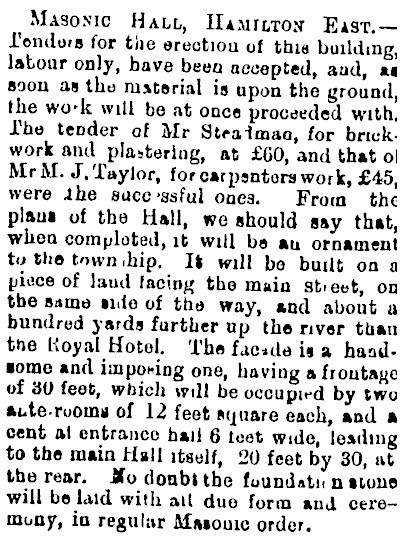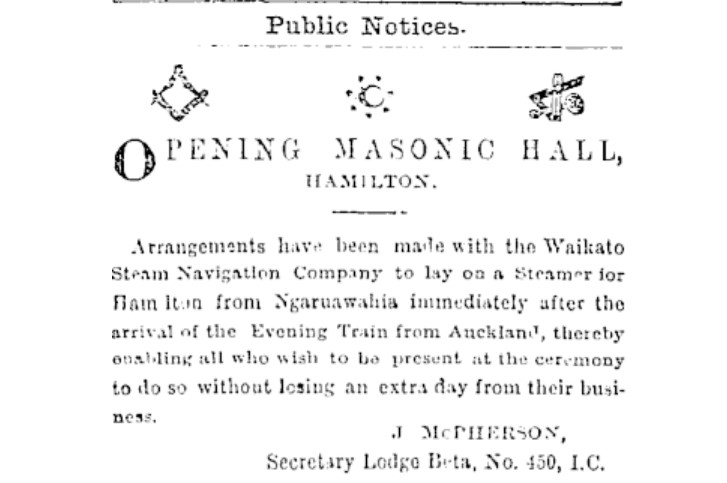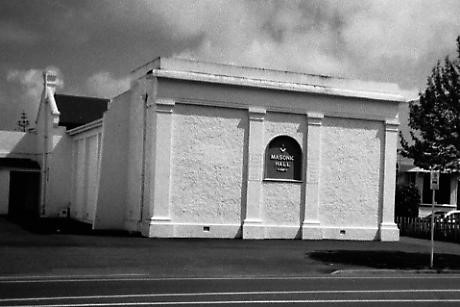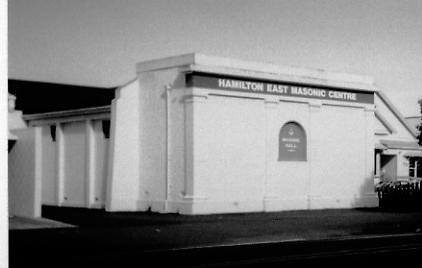The Hamilton East Masonic Lodgeroom
I J Nathan
Just nine months after elements of the British army arrived in what was to become the township of Hamilton a meeting was held to discuss the possibility of forming a masonic lodge. Not surprisingly most of those at that meeting were from the military. This meeting on 25 May 1865 was chaired by Major Brother Jackson Keddell and others included Captain D M Brown, Lieutenant A Porgue, Capt A W East, Colour Sergeant McGowan and Ensign B Turner. A petition was drawn up and was forwarded to the Provincial Grand Master, Irish Constitution. In considering where to hold their lodge meetings two interested former military brethren turned hotel keepers both offered to host the lodge. The decision was made to accept the offer of former Ensign Harris at his Royal Hotel. This hotel was located on the corner of what is now Grey Street and Cook Street on the car park of the present business Liquorland. The accommodation offered was a room 18 feet by 16 feet with a stud of nine feet together with two ante rooms.
The lodge was constituted as The Beta-Waikato Lodge No 450 IC on 16 December 1865. While their facilities were adequate when the Lodge was relatively small, after a few years the accommodation became rather cramped. On 22 April 1875 the Lodge resolved to build its “own hall for masonic purposes”. A committee was appointed to carry out this resolution and had its first meeting on Tuesday 11 July.
William Cumming, Master of the Lodge, who owned a local brewery donated the section on which the Hamilton East lodgerooms still stands. It measured 45 feet wide by 80 feet deep and was valued at £150. Six members of the committee donated a total of £50. It was also agreed that masonic brethren throughout the district would be invited to make donations for the work. Bro F R Claude, after whom Claudelands was named, gave £100. Bro I R Vialou, an architect and later to become the first mayor of Hamilton, offered to prepare the necessary plans free of charge and another brother agreed to carry out the legal requirements on the same terms.
Labour only tenders were called for the bricklaying and carpenter (sic) in an advertisement in The Waikato Times. The closing date was announced as Tuesday 19 September 1876. The successful tenderers were a Mr Steadman for the brickwork and plastering for £60 and Mr M J Taylor for the carpentry at £45.


The Waikato Times of 5 October 1876 reported that `from the plans for the Hall, we should say that, when completed, it will be an ornament to the township. … The façade is a handsome and imposing one having a frontage of 30 feet, which will be occupied by two ante rooms of 12 feet square each, and a central entrance hall six feet wide, leading to the main Hall itself, 20 feet by 30, at the rear. No doubt the foundation stone will be laid with all due form and ceremony, in regular Masonic order.’
And indeed it was. The foundation stone was laid with great pomp and ceremony on 9 November 1876 according to the masonic ritual. This was on the birthday of the Prince of Wales who was the Grand Master of the United Grand Lodge of England. It was also a public holiday in Hamilton. Freemasons from all around the district attended the ceremony. The Waikato Times wrote of the many gaily dressed holidaymakers and the carriages filled with the ladies. The lodge members set off in procession from the Royal Hotel to the site of the new lodgerooms. A harmonium and the Hamilton Church Choir were on a platform on which a tent had been erected. The presiding minister, the Rev W Calder, was a Freemason and Vicar of St Peters and his wife played the harmonium.
Gold, silver and copper coins of the realm together with a copy of The Waikato Times in a bottle were placed in a cavity of the foundation stone which was then lowered into place while the Choir sang `When Earth’s Foundations First were Laid’.
After the ceremony the masonic brethren, their ladies and guests were then entertained at a déjeuner. This was a cold collation prepared by Capt Dawson the new host of the Royal Hotel and laid out in an attractively decorated Town Hall. This Hall was opposite the Royal Hotel and was demolished late in the 19th century. Capt Dawson became the Master of the Lodge in 1879 and also mayor of Hamilton the same year.
The déjeuner was a `well supplied, well cooked, elegantly set out repast such as would task the happiest efforts of the best provided hotels and the best cuisines in the colony to match. … The dinner passed off most agreeably as indeed it should not otherwise do when such excellent provision had been made and where the hosts were so obligingly attentive to their visitors.’ So The Waikato Times reported the occasion. Following a lengthy toast list the gathering dispersed.
Isaac Coates had the first burn of bricks at his new brickyard in February 1876 and he supplied the bricks for the building. His advertised charge was £2.10. 0. per thousand. His brickworks were just north east of Steele Park in the Street named after him. Coates, who became mayor in 1880 later joined the lodge but never made the Master’s chair. He was a man with many interests; he was a flax miller, a threshing contractor, a farmer, an importer of seeds and was the successful tenderer to construct the Puniu section of the Main Trunk Railway which included three substantial bridges.
The lodgerooms had been built at a cost of £600
The formal opening of the Beta-Waikato’s lodgerooms was set for Thursday 23 August 1877. The Provincial Grand Master, RW Bro G P Pierce, and a large team of Grand Lodge officers from Auckland were to conduct the ceremony. The only commercial transport at this time was by Quick’s coaches. The railway line from Auckland had reached Ngaruawahia and the first official train ran just 10 days earlier. This train had left Auckland at 7 a.m. and reached Ngaruawahia six hours later.
 The Lodge Secretary, Capt James McPherson, placed an advertisement in The New Zealand Herald two days before the opening ceremony was to be held advising that a steamer had been laid on for Hamilton from Ngaruawahia immediately after the arrival of the evening train thereby enabling all who wished to attend to be present without losing an extra day from their businesses in Auckland. Because of the very large number of visiting masons the Lodge opened two hours late at 2 p.m.
The Lodge Secretary, Capt James McPherson, placed an advertisement in The New Zealand Herald two days before the opening ceremony was to be held advising that a steamer had been laid on for Hamilton from Ngaruawahia immediately after the arrival of the evening train thereby enabling all who wished to attend to be present without losing an extra day from their businesses in Auckland. Because of the very large number of visiting masons the Lodge opened two hours late at 2 p.m.
After the normal business had been finished all the Freemasons formed up into processional order and marched to St Peters church on the other side of the river. At this time there was no bridge and neither The New Zealand Herald nor The Waikato Times recorded how this feat was accomplished. The first bridge over the Waikato river at Hamilton was not opened until November 1879. Prior to this punts were used to cross from one side to the other.
A considerable number of the public, especially ladies were present and the church which held 300 was full. A full choral service was concluded by a short, impressive and spirited sermon by Rev W Calder. The procession re-formed and returned to the lodgeroom where the Grand Lodge officers continued the ceremonies with oblations of corn, wine and oil and consecrated the new Hall. After the invocation by the Chaplain the Provincial Grand Master, RW Bro G P Pierce, addressed the meeting which was then closed with solemn prayer.
The Freemasons then adjourned to the Town Hall to a banquet `which left nothing to be desired for’. At the conclusion of a lengthy toast list the brethren dispersed.
They re-assembled in the large room of the Commercial Hotel where the Inauguration Ball was to commence at 9 p.m. There were twenty two dances including quadrilles, galops, polkas, mazurkas, lancers, schottisches and waltzes. `Accommodation, music, provisions, delicacies etc. were provided on the most liberal scale and the floor was in first rate order.’ All present enjoyed themselves and `the dancing was kept up till 5 o’clock in the morning and as by this time the visitors had to study their means of locomotion, especially those who wanted to reach Auckland, a dispersion took place’.
The Lodge settled down to work and its membership increased steadily. This increased its income and on 19 October 1893 the mortgage had been paid off and the Lodge was declared free of debt. The growth in its membership led to another problem; a shortage of accommodation. The two ante rooms, each 12 feet square were too small for the members at supper and the lodgeroom was cramped. As at 31 December 1900 the membership was 54 and this had swollen to 88 by 31 December 1904. So not surprisingly the Lodge acquired additional land from Isaac Coates for any expansion. The original section was ·0826 acre or 13·2 perches. The additional land purchased from Coates was 13 perches. The total section now measured 65 feet wide and 110 feet deep. On 17 July 1908 ownership of the land was transferred to the Lodge’s trustees; Harold Coop auctioneer, David Lusby of Kirikiriroa, farmer and Campbell Larnach MacDiarmid, solicitor.
Plans were also drawn up to extend the Lodge building and were authorised on 16 January 1908. The front wall of the building was moved 12 feet closer to Grey Street and the central door was not replaced. At the back of the building an entrance porch was built. This measured 42 feet across the building and was 18 feet wide and had an open fireplace at the southern end. This room was also used as the refectory and had coat hooks placed on the east wall for coats. A door on the west wall led to a small kitchen. It would appear as though the two ante rooms were removed and the main lodgeroom was increased to 32 feet by 30. The entrance to the lodgeroom itself was via a new door in the west wall. The extension to the eastern end was possibly used for extra seating and is the present `east’. Unfortunately no record is available on what was actually done so what is here written is a best guess. The new entrance was reached by a path 12 feet wide on the north side of the building. To finance this work the Auckland Savings Bank granted a loan of £444.
On 31 December 1918 membership reached 91 and the following year it climbed to 95.

The Lodge in 2005

The Lodge in 2005 with a new name
On 9 August 1920 a committee was appointed to consider the possibility of erecting a new lodge building. Lodge Tawhiri No 166 was meeting at that time in Kent Street and a meeting with the representatives of that Lodge was held with a view to building a new facility for both lodges. This never proceeded past the talk stage. Another committee was elected on 11 June 1923 and tasked with providing adequate accommodation for The Beta-Waikato Lodge. Its deliberations were more fruitful. A section on the corner of Myrtle Street and River Road was purchased. A new lodgeroom was started on April 1924 and completed in August the same year.
The last meeting in the lodgerooms in Grey Street was held on 10 September 1924 and the lodgerooms were vacated.
The move was probably just in time because its membership in June 1925 was 151.
The building remained empty and derelict, unloved and unwashed.
The possibility of a third lodge opening in Hamilton became quite possible following a meeting on 31 March 1927. The possibility became real when, after several meetings, Lodge Hamilton No 291 was constituted on Thursday 22 September 1927 in the lodgerooms in Kent Street.
Although the new lodge was very keen to use the Grey Street lodgerooms it had not been in use for three years. When they were vacated by The Beta-Waikato Lodge in 1924 they were in need of renovation. Three years later they were in a very poor condition. Ivy which had grown unchecked over the outside of the building had also spread its branches into the interior. It had in fact been under offer to the Hamilton Borough Council as a truck depot.
Lodge Hamilton was offered the use of the building for a yearly rental of £35 with the option of purchase for £1475. It decided to rent but on Monday 17 December 1928 the Lodge resolved to purchase it for £700. It was to be 18 months of working bees to restore the lodgerooms to a habitable state. The first meeting of Lodge Hamilton in its new Hamilton East lodgerooms was held on 18 March 1929. On 15 July 1929 the land was transferred to George Edgecumbe, gentleman, Campbell Larnach MacDiarmid, solicitor, Alfred Bullock, timber merchant, Edgar Aldrich Bryant, butcher, and Henry Bath Jenkins, farmer who were the trustees of The Beta-Waikato Lodge. It was to be nearly three months later, on 21 October 1929, before ownership of the land was transferred to the trustees of Lodge Hamilton.
With a membership of only 42 the renovated lodgerooms were found to be perfectly satisfactory. However, Lodge Hamilton steadily grew in numbers and by 1939 it had 86 members. It was also steadily paying off its debts and in June 1942 the Treasurer announced that the building was mortgage free. In 1949 its membership had reached 130 and in 1955 it had climbed to 150 and was still rising. The old lodgeroom couldn’t cope.
Adding to the difficulties was that on 7 July 1951 another masonic lodge was constituted. This was Lodge Hillcrest No 363 and this became a tenant lodge in the Hamilton East lodgerooms. Although its foundation membership was 35 this had increased to 53 by 1955.
In 1956 tenders were called for an extension of the building. Three construction firms put in tenders but the successful quote was the firm C L Rawlinson & Co Ltd. Bro C L Rawlinson was a member of Lodge Hamilton and had in fact drawn up the detailed plans for the work. Building Permit number 10149 was issued by the Hamilton City Council on 27 February 1957 and vaguely stated that it was for additions and alterations for the Hall but again there is no detailed record. The alterations actually involved widening the lodgeroom by approximately seven feet on each side. This involved the pulling down of the existing outside north and south walls which had been built 79 years earlier. A new kitchen was built as well as a cloak room and toilets. Following its meeting in February 1957 the Lodge met in the lodgerooms of Lodge Tawhiri in Kent Street until June before returning to its renovated rooms in Hamilton East.
Lodge Hillcrest which had been meeting in the Hamilton East lodgerooms for some eleven years was desirous of having its own facilities.
W Bro P J Oliver, the secretary of Lodge Hamilton and later to become Grand Secretary, put forward the suggestion that Lodge Hillcrest should be offered an equal share in the ownership of the land and buildings if it would build a more spacious refectory.
Both lodges took this suggestion seriously and on Monday 29 July 1963 a meeting comprising eight representatives discussed it. The meeting was informed that the proposed refectory would cost approximately £3500 and would seat between 190 and 200. Lodge Hamilton then informed the meeting that it still owed between £1700 and £2000 for the 1957 alterations. The Lodge Hamilton representatives were prepared to suggest on behalf of their lodge that Lodge Hillcrest be offered an equal share in the ownership of the land and buildings at Grey Street provided that Lodge Hillcrest undertook to finance the suggested alterations for the refectory. Lodge Hamilton would remain responsible for the balance owing as a result of the 1957 alterations. If agreement could be reached it was envisaged that the building could be managed by a Management Committee with equal representation from each lodge.
A second meeting of the lodges’ representatives took place on 29 October 1963 and their deliberations changed tack. This meeting resolved that the Standing Committees of both lodges consider and if agreeable adopt the proposal whereby Lodge Hillcrest paid to Lodge Hamilton £1750 and that a sum of up to £4000 be raised by the two lodges as joint owners by way of a mortgage in order that expansions to the refectory, as planned, could proceed. The effect of this scheme was that Lodge Hillcrest would pay off the outstanding debt on the 1957 alterations and the cost of building a new refectory would be born jointly. This plan was however rejected and the original proposal reinstated.
There were two other matters that required a resolution; matters that were not even dreamed about in 1908. Firstly, there was some doubt as to whether additional off street parking for cars might be required. It was reported at a further meeting on 20 September 1964 that the Council had agreed that the planned alterations constituted an extension of the refreshment facilities only and not an extension to the Hall. Consequently no provision for off street parking would be necessary.
The second matter involved meeting with the owner of the adjoining property in Wellington Street. She was not happy at the proposal to build a wall on the common boundary and sought assurances concerning the height of the planned fence and reluctantly accepted it. The City Engineer advised that if there had been any change in the ownership of the adjoining property since 1957 it would be necessary to get fresh approval for any extensions which would affect the boundary wall. There had been no change in the ownership of the neighbouring property.
Agreement was reached between the two lodges which in broad terms were that Lodge Hillcrest was to build the refectory according to plans agreed to by both lodges and that Lodge Hamilton would be responsible for the paying of the debt incurred for the 1957 alterations. So Lodge Hamilton and Lodge Hillcrest became equal joint owners of the land and complex which was to be controlled by a management committee which was to have equal numbers from each lodge.
Tenders were called for the erection of the new refectory and J I Hooker won the contract with his tender of £3507. Jack Hooker later was to be Master of Lodge Hillcrest and a Grand Lodge officer.
On 15 December 1965 another masonic lodge was constituted in Hamilton. This was Lodge Hamutana No 437 which became a tenant lodge of Lodge Tawhiri in the Kent Street lodgerooms. It started life with sixty members but by 1976 this had reached 88. It had entered into negotiations with Lodge Tawhiri which it was hoped would lead to joint ownership of the land. and building. However, agreement could not be reached and Lodge Tawhiri was informed on 5 February 1980 that it was unable to proceed with the amalgamation.
Lodge Hamutana later moved to the Hamilton East Masonic Centre and held its first meeting there on 27 August 1989. Soon after this Hamutana entered into dialogue to become a joint owner of that building. After the payment of a large four figure sum to the Building Committee, joint ownership of the complex by the three lodges was confirmed. This was recorded on the South Auckland Land
District register on 27 February 1998 that the trustees (named) of Lodges Hamilton, Hillcrest and Hamutana each held a third share of the centre.
The only major structural change to the building since 1957 was the provision of an additional exit to the lodgeroom on the north side. This was required for the building to meet the fire regulations for emergency evacuation.
In July 2004 Lodge Hamilton relinquished its Charter and the ownership of the building now became the joint possession of Lodges Hillcrest and Hamutana. This change was registered with the Land Information of New Zealand (LINZ) on 9 August 2004.
The management of the complex is in the hands of a committee with equal representation of the two owner lodges. It is a very effective committee and has maintained the building inside and out extremely well. It is a pleasant complex to hold meetings in, warm in the winter and cool in the summer. Gas heating is used to heat the various rooms.
The last change to the lodgeroom was the fitting of two handrails to the East in early 2007.
The facilities are well used by the various Masonic bodies meeting there. Apart from the owner Lodges Hillcrest and Hamutana the following Masonic groups meet in it; Lodge Pukemiro No 301, the Hamilton Chapter Rose Croix No 332, New Zealand Constitution, the Waikato Sovereign Chapter Rose Croix No 37, Scottish Constitution, the Waikato Sovereign Council No 24, Scottish Constitution, the Waikato Council No 121 of the Allied Masonic Degrees and the Waikato Conclave No 8, Secret Monitor. Two Royal Arch Chapters also convene in the building; Waikato No 22 and Te Marama No 54. The Order of the Eastern Star also meets in the complex.

Acknowledgement
Acknowledgement is made to the Hamilton Public Library for the 1900 photograph of the building.
In compiling this history the author used material from the published histories of Lodges The Beta-Waikato, Hamilton, Tawhiri, Hillcrest and Hamutana.
Additional material was sourced from The New Zealand Herald and The Waikato Times.
